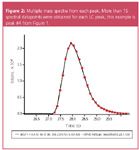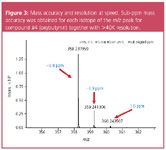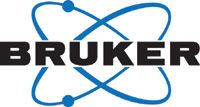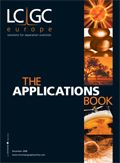maXis High Resolution LC–MS Makes the Most of Ultrafast LC Separations
The Application Notebook
An ultrafast gradient LC separation method was developed to separate a 5-component drug mixture in 30 seconds, with peak widths of 1 second. maXis mass accuracy at sub-ppm levels and true isotopic pattern of the spectra from the peaks lead to a confident elemental formula assignment for each drug compound with the SmartFormula algorithm.
Catherine Stacey, Sebastian Goetz and Carsten Baessmann, Bruker Daltonik GmbH, Bremen, Germany.
An ultrafast gradient LC separation method was developed to separate a 5-component drug mixture in 30 seconds, with peak widths of 1 second. maXis mass accuracy at sub-ppm levels and true isotopic pattern of the spectra from the peaks lead to a confident elemental formula assignment for each drug compound with the SmartFormula algorithm.
Introduction
Modern discovery applications demand definitive MS results on ever more complex samples. maXis is the only mass spectrometer able to deliver the maximum MS performance specification at the very highest speeds made available by modern ultrafast liquid chromatography. Here, a complete gradient LC separation of typical drug molecules is achieved in 30 seconds, with each component detected with sub-ppm mass accuracy.

Figure 1
Experimental
A drug mixture (norharmane, sulphamethazine, sulphamethoxazole, oxybutynin and terfenadine) was separated by an ultrafast separation LC (U-HPLC) using a flow-rate of 0.5 mL/min and a gradient from 4% acetonitrile to 95% acetonitrile in 0.5 mins. The maXis electrospray LC–MS dataset was acquired with an acquisition rate of 10 Hz. The dataset was automatically recalibrated in the Compass DataAnalysis 4.0 processing software with several masses of salt clusters resulting from a loop injection of lithium formate solution (10 mM in water/isopropanol) at the end of the separation.

Figure 2
Results
The separation of the 5 drug mix gave baseline resolution of each compound within 30 seconds (Figure 1). For each peak more than 15 spectral measurements were made across each peak, to give reproducible peak areas suitable for quantitative analysis (Figure 2). In the mass spectrum, the mass accuracy for each peak of the isotopes is below 1 ppm, with a resolution of 43700 — acquired at an acquisition rate of 10 Hz (Figure 3). SmartFormula analysis is automated in the Compass 1.3 data processing software. SmartFormula automatically determines the possible elemental compositions of each compound LC peak, using a mass accuracy of < 2 ppm error with allowed chemical rules and elements (CnHnNnOnSn). Formulae are ranked according to the closest match factor between the measured isotopic pattern and the theoretical pattern for a given formula — the Sigma value, which should be close to zero. For these drug compounds, a unique SmartFormula result was produced within the allowed mass accuracy and Sigma values (Figure 4). Peak 4, Oxybutynin (Figure 5) was unequivocally confirmed in this experiment.

Figure 3
Conclusion
The maXis is an ideal instrument for maximum MS performance at the very highest speeds delivered by modern ultrafast chromatography. Sub-ppm mass accuracy is shown for small molecule drugs, together with a resolution in excess of 40000. Thus the instrument allows extraction of full quantitative information from high speed chromatography. Supported by SmartFormula, the maXis provides unequivocal molecular formula determination capabilities. For compounds with higher molecular weight (up to 1000 Da) SmartFormula 3D is using MS–MS fragment data for certainty in small molecule identifications.1

Figure 4
For research use only. Not for use in diagnostic procedures.
Reference
1. Bruker Daltonics Technical Note-23, "Certainty in Small Molecule Identification by Applying SmartFormula 3D on a UHR-TOF Mass Spectrometer."

Bruker Daltonik GmbH
Fahrenheitstr. 4, 28359 Bremen, Germany
tel. +49 421 2205 0 fax +49 421 2205 104
E-mail: sales@bdal.de
Website: www.bdal.com

New Method Explored for the Detection of CECs in Crops Irrigated with Contaminated Water
April 30th 2025This new study presents a validated QuEChERS–LC-MS/MS method for detecting eight persistent, mobile, and toxic substances in escarole, tomatoes, and tomato leaves irrigated with contaminated water.
University of Tasmania Researchers Explore Haloacetic Acid Determiniation in Water with capLC–MS
April 29th 2025Haloacetic acid detection has become important when analyzing drinking and swimming pool water. University of Tasmania researchers have begun applying capillary liquid chromatography as a means of detecting these substances.
Prioritizing Non-Target Screening in LC–HRMS Environmental Sample Analysis
April 28th 2025When analyzing samples using liquid chromatography–high-resolution mass spectrometry, there are various ways the processes can be improved. Researchers created new methods for prioritizing these strategies.

.png&w=3840&q=75)

.png&w=3840&q=75)



.png&w=3840&q=75)



.png&w=3840&q=75)










